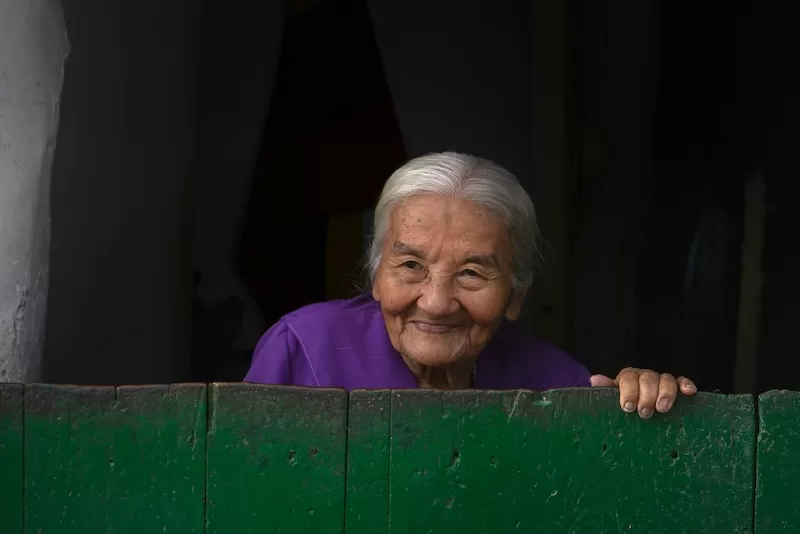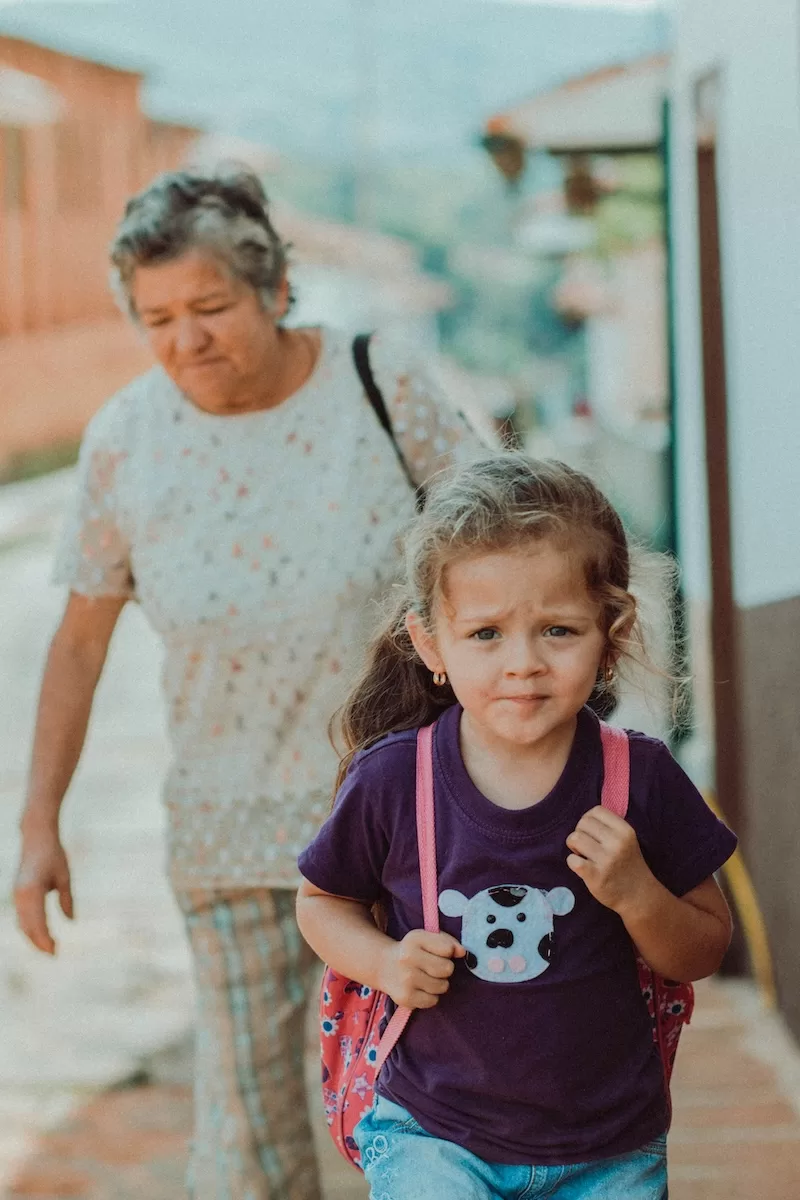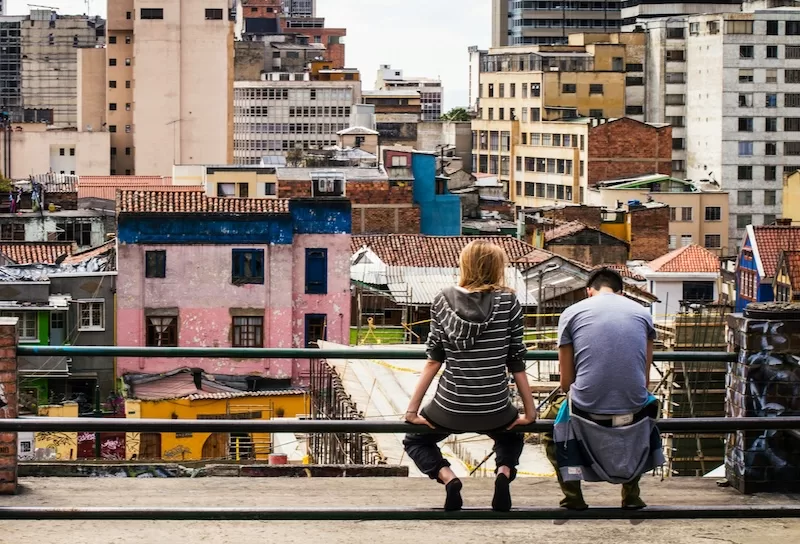Introduction
Imagine stepping into a living room in Bogotá on a Sunday afternoon. The front door never really closes; it swings open to a steady flow of aunts, cousins, and neighbors carrying trays of arepas or jugs of juice. Laughter drifts from the kitchen, where abuela tells an old love story while stirring her pot of sancocho, pausing only to scold someone for forgetting the cilantro. Children zigzag between chairs, their socks sliding on tiled floors, while a soccer match hums from the television in the next room. The air feels full of movement, noise, and affection so casual it becomes part of the background.
Family life in Colombia lives in these layers. It is not a tidy category of mother, father, and child but a living system built on connection, duty, and shared joy. Affection often arrives in the form of teasing. Belonging is measured by how many people drop by unannounced. Stories are preserved through repetition around the dinner table, retold until they become family folklore.
This article explores that pulse in detail. It looks at how Colombian families have evolved through changing times, how traditions endure in cities of glass towers, and what it means to live within this web of kinship as a local, an expatriate, or a curious observer drawn to the everyday pulse of life in Colombia.
Why This Matters to You
For anyone arriving in Colombia (either for a few weeks, months or for good) understanding family life offers a key to understanding the country itself. Family shapes nearly every social interaction, from how people greet each other to how communities are built. What might seem like casual friendliness to an outsider is often rooted in deeply held values of kinship and trust.
Travelers who know this step into Colombian life with greater ease. When someone invites you to lunch after a brief conversation, it is not politeness but genuine inclusion. The invitation often extends beyond a meal to an introduction into their circle, from parents and siblings to cousins and lifelong friends who blur the line between family and community. Accepting that warmth with openness often leads to experiences that no guidebook can offer: a home-cooked meal in a countryside kitchen, an impromptu dance at a family celebration, a friendship that endures long after you leave.
For expats considering a move, family life provides the foundation for belonging. In Colombia, social networks are built around personal relationships, not institutions. Knowing how family works means knowing how society works. It explains why business meetings often begin with small talk about family, why weekends are reserved for reunions, and why trust develops through repeated shared moments rather than transactions.
Understanding family life in Colombia helps travelers and new residents bridge the cultural gap between observation and participation. It allows them to see the country not just as a destination, but as a living, breathing network of homes, each one full of conversation, food, and the comforting togetherness that defines Colombian life.
Read More Like This: Getting Residency in Colombia
The meaning of family in Colombia
Cultural roots and values
In Colombia, familia carries a weight that goes beyond bloodlines. It is both a structure and a feeling, a network that folds in godparents (padriños), aunts, uncles, and even neighbors who have become family through time and shared meals. The family is the core of social life, the first circle of trust, and often the main source of support in moments of joy and crisis. According to the Cultural Atlas, the family remains central to Colombia’s social fabric, with homes functioning as spaces of belonging long after children reach adulthood. It is common for young adults to live with their parents until marriage, not as a sign of dependency but as a continuation of the family bond.
Respect for elders runs deep. Age brings authority and a reverence that shapes daily customs. In many households, the oldest person at the table is served first. Advice from grandparents carries moral weight, and decisions often consider their approval. This sense of hierarchy is not imposed by rule but by affection, a recognition that experience deserves attention.

The role of extended family
Even when not under one roof, extended families remain close in rhythm and distance. Many live in the same neighborhood or make weekend visits part of their routine. Shared meals, phone calls, and small acts of help, like watching a child, lending a car, or cooking a favorite dish, are threads that hold the wider family together. In working-class and rural areas, multigenerational households are particularly common, blending old and new customs under one ceiling.
Think of a home as a living hub: cousins sprawled on the couch, grandparents rocking gently by the doorway, siblings moving in and out of rooms carrying laundry or snacks. The day unfolds in conversation, in background music, in the steady pace of cooperation. Children learn not only how to care for others but how to belong: to understand that family is not a static noun but a continuous act of participation.
Household composition and changing patterns
Nuclear, single-parent and other household types
The traditional image of a Colombian household—mother, father, and two children—still lingers, but the country’s family structures have grown far more varied. Across Colombia’s cities, family forms now reflect the social and economic shifts of a modernizing nation. A study across four urban centers found that nuclear families accounted for about 54.6% of households, while female-headed single-parent families made up nearly 29.4%.
Behind those figures lies a story of adaptation. Rising urbanization, greater mobility, and evolving gender roles have expanded what “family” can mean. Single-parent homes have become more visible. Blended families (formed after separation or migration) add new layers to domestic life. Smaller households are now common in the cities, shaped by economic realities and the growing cost of living. In rural areas, extended kin still hold together under one roof or nearby, maintaining older patterns of interdependence.
These variations show Colombia’s transition: a society balancing tradition with the practicalities of contemporary life. The concept of family remains steady, even as the form it takes continues to diversify.
Fertility trends and family size
Across Colombia, family size is contracting. The country’s fertility rate has fallen sharply over recent decades, from 6.4 births per woman in 1960 to around 1.6 in 2024. This demographic shift signals a profound change in how households are built and sustained.
Smaller families mean quieter homes and new rituals of daily life. Parents often devote more resources to each child, while siblings grow up in smaller peer circles. In some neighborhoods, the laughter of three or four generations living together has softened into the sound of one or two. Yet the intimacy of Colombian family life endures, even as its shape contracts.
These trends mark a gradual redefinition of what home looks like. Less crowded perhaps, but no less connected, with the emotional thread of kinship remaining intact.
Everyday habits in Colombian homes
The Pulse of the Kitchen
In most Colombian households, life revolves around the kitchen. It is both stage and sanctuary, the place where mornings begin and evenings wind down. Coffee brews before sunrise, filling the air with a dark, earthy scent. By midday, pots simmer with rice, beans, or soup, and the kitchen fills with conversation that blends the serious and the lighthearted. Mealtimes are not rushed. They move slowly, with pauses for storytelling and teasing, the steady clink of plates, and the background sound of a radio or television.
Food is less about sustenance and more about connection. Grandmothers still cook recipes that have survived generations, and younger family members learn to replicate them through observation, not written instruction. It is in these moments that family stories are passed along, folded into conversation like another ingredient.
Intergenerational Bonds and Children’s Routines
Family life in Colombia thrives on a sense of shared responsibility. Parents and grandparents often collaborate in raising children, offering both structure and emotional grounding. A cultural guide on Colombian families notes that children grow up with a strong awareness of respect toward their elders, especially their mothers. Older siblings help with younger ones, and daily chores are often collective efforts rather than individual duties.
Children learn early how to participate in the inner workings of the home. Helping set the table, greeting visitors politely, or caring for pets are considered small but meaningful contributions. This participation builds a sense of belonging and accountability that extends into adulthood.

The Soundtrack of Home
Homes in Colombia are rarely quiet. The soundtrack is a mix of voices, music, and movement. A blender running for a midday juice, the echo of laughter from the courtyard, a motorcycle passing outside the window. Visitors are frequent, and privacy is fluid. A cousin may stop by without warning; a neighbor might lend sugar and stay for coffee. This openness reflects a cultural warmth where hospitality and spontaneity blend effortlessly.
For expats adapting to life here, these sounds and gestures become part of daily comfort. The sense of openness, the constant flow of people and conversation, often fill the space that newcomers initially miss when leaving their own families behind.
Urban and Rural Differences
Family habits shift with geography. In cities like Bogotá, Medellín, or Cali, apartments are smaller, schedules are tighter, and families adapt to urban pace. Parents balance long commutes and workdays, while children often attend school full-time and join extracurricular activities. Meals may be shorter but still anchor the day.
In rural areas, the tempo slows. Extended families might share a single property, and several generations work side by side. Children grow up surrounded by farmland or open spaces and may help with agricultural work or family businesses. Sundays bring long lunches, religious observance, and time outdoors.
These differences shape how family life in Colombia feels from one place to another. Urban families may value independence and education opportunities, while rural households prioritize community and proximity. Yet both share an underlying togetherness that holds Colombian society steady.

Religion, Rituals, and Weekly Gatherings
Religion continues to shape the weekly calendar. Many families attend Mass together on Sundays, followed by a communal lunch that stretches into the afternoon. Baptisms, first communions, and weddings are celebrated with large gatherings where food, music, and faith intertwine. Even in secular households, these traditions linger as cultural habits, marking the passage of time through shared ceremony.
Challenges and transitions for Colombian families
Economic Pressures and Migration
Across Colombia, the pressures of daily life weigh heavily on the household. Economic shifts and the rising cost of living have altered how families share responsibilities and resources. Many parents balance long work hours in cities or abroad, leaving grandparents or older siblings to manage home life. Internal migration has redefined family proximity. Networks that once lived within walking distance are now stretched across regions or even borders, relying on phone calls, remittances, and brief reunions to stay connected.
Still, family loyalty endures. Even when miles apart, Colombian relatives remain in close contact, their relationships maintained through digital conversations and shared financial support. Migration has not broken the family structure, only reshaped its geography.
Shifting Gender Roles
Gender expectations are evolving, though tradition continues to cast a long shadow. In many homes, women still carry the emotional and logistical weight of caregiving, while men are often seen as providers. But this balance is changing. Women’s participation in the workforce has increased significantly, creating dual-income households that challenge long-held norms. According to cultural studies, traditional “machismo” and “marianismo” ideals (where men protect and women nurture) remain visible but are losing their dominance.
This gradual redefinition has ripple effects. Shared parenting, flexible gender roles, and greater educational opportunity for women have become part of the new domestic landscape. At the same time, these transitions can create friction: generational expectations may clash with modern aspirations, and the demands of economic survival can strain even the closest bonds.
Education, Labour, and the Changing Demographic Map
Education has transformed the timeline of family formation. As access to schooling and higher education improves, young Colombians are delaying both marriage and parenthood. A generation ago, many couples started families in their early twenties; now, it is increasingly common to wait until economic stability is secured.
This shift aligns with Colombia’s falling fertility rate. Smaller family sizes and delayed childbearing have produced households that look different from those of their parents’ generation. The result is a society with fewer large families, more single-parent homes, and more women leading households.
Urban Strain and Economic Adaptation
In cities, housing costs and limited space intensify these challenges. A two-bedroom apartment in Bogotá or Medellín can consume a significant share of household income, leaving families to adapt by cohabiting across generations or moving to satellite towns. Informal economies also sustain many families, from street vendors to home-based businesses that allow parents to work while remaining present for their children.

Economic resilience is a skill shared across Colombian homes. Families stretch resources creatively, rely on community solidarity, and sustain optimism through connection. Despite structural challenges, the collective spirit of familia continues to act as a stabilizing force in uncertain times.
What living in a Colombian family feels like
Sensory Snapshots: Voice, Space, Connection
Step into a Colombian household on a Saturday afternoon, and life plays like a continuous scene rather than a sequence of moments. Midday light spills through the veranda in Cartagena, catching on the glazed tiles. Grandmother stands by the stove, stirring rice and beans in a deep pot that smells of garlic and cumin. Toddlers chase a dog across the courtyard while an uncle tunes a radio to vallenato, its melody weaving softly through the chatter. Older cousins scroll through their phones, half listening, half teasing each other. Somewhere outside, a street vendor calls out, his voice blending with laughter and clinking glasses.
This is the texture of family life in Colombia: fluid, full, and rarely quiet. The line between private and social space blurs; doors are open, voices overlap, and affection travels through gestures rather than grand displays. A hand on the shoulder, a shared plate, a casual “¿Comiste?” carries more care than a speech could.
Afternoons often slow into something communal. Someone cuts tropical fruit and passes slices around without asking. A child runs in with a scraped knee and is instantly tended to by three adults. These small interactions reveal how family life here is built not on order or discipline but on presence. The rhythm is organic, unplanned, and alive.
The Unspoken Codes of Hospitality
For visitors or newcomers, joining a Colombian family gathering can feel like walking into a play already in motion. Everyone talks at once, and somehow everyone understands each other. Greetings are physical (handshakes, kisses on the cheek, a pat on the back) and introductions blur into immediate inclusion. Guests are fed before they finish saying they are not hungry.
Meals stretch far beyond the food itself. Lunch can dissolve into coffee, then into conversation that lingers through the afternoon. Leaving abruptly is almost unthinkable. The right move is to relax, accept another cup, and let the tempo pull you in. Flexibility matters more than punctuality. If plans shift, they shift together.
Children move freely between rooms and conversations, often watched by several adults at once. Grandparents may offer quiet advice; teenagers might drift between helping and laughing from the sidelines. The household runs on collaboration, not hierarchy.
Finding Your Groove as a Newcomer
Those planning to build a life in Colombia with family will find that connection forms quickly. Neighborhoods in cities like Medellín or Bucaramanga often have their own micro-communities, where children play outside together and parents share school runs or weekend gatherings. Public and private schools vary in quality, but both tend to emphasize community, shared values, and respect for elders.
Proximity to relatives or friends is a practical consideration. Many families choose housing that keeps them within reach of grandparents or cousins. In smaller towns, this proximity is built in; in cities, it may take deliberate planning. Still, Colombians tend to nurture relationships through regular visits, phone calls, and celebrations that bring everyone back to the same table.
For those settling in Colombia, being welcomed into a family gathering (offered food, laughter, or a seat at the table) often marks the moment when the country stops feeling foreign and starts feeling like home. To live within it is to accept that family is not a backdrop but the main storyline.
Read More Like This: 3 Tips for Living in Colombia
Looking ahead: the future of family life in Colombia
The trajectory of family life in Colombia points toward smaller households, more fluid gender roles, and deeper integration of urban rhythms. With fewer births, the average family unit may shrink, and generational overlap might reduce. Technology and mobility continue to play their part.
Still, the core value of family (connection across generation, shared meals and mutual support) remains resilient. While forms change, the heartbeat of family life in Colombia stays steady: people looking out for each other, adapting to new realities, and building routines that reflect their place, their past and their hopes.

FAQs
Q1. At what age do children typically leave home in Colombia?
Many children stay until marriage or stable employment; living with parents through early adulthood is still common in several regions.
Q2. How common are multigenerational households in Colombia?
While nuclear households dominate in urban zones, homes with grandparents and extended family nearby remain significant especially in less urbanized areas.
Q3. Are single-parent families increasing in Colombia?
Yes. According to data from Population Review, female-headed single-parent households now make up nearly 30% of Colombian families. This rise reflects broader social changes, including migration, economic independence among women, and evolving attitudes toward marriage and family formation.
Q4. How do family traditions differ in rural vs urban Colombia?
Rural families tend to preserve more traditional patterns: large households, close proximity among relatives, and communal routines tied to land or local trade. Urban families, especially in Bogotá, Medellín, and Cali, are smaller and more private, often juggling tight schedules and professional demands. Despite these contrasts, both settings share a deep sense of hospitality and family loyalty.
Q5. Does family life in Colombia emphasize any particular values?
Respect for elders is central, as is the idea that family comes before the individual. Strong bonds between mothers and children, frequent family meals, and collective responsibility are pillars of Colombian domestic life.
Q6. Are gender roles still traditional in most Colombian households?
They are evolving but not disappearing. In many families, women still manage the home and emotional life of the household, while men handle external or financial matters. Yet younger generations are steadily reshaping these roles, emphasizing partnership and shared responsibility.
Q7. What can foreigners expect when visiting or joining a Colombian family?
Expect warmth, food, and a sense of inclusion that can feel immediate. Guests are treated as part of the family from the first greeting. Mealtimes may last for hours, conversations overlap, and schedules flow with flexibility. The best way to fit in is to participate: share a story, help serve food, and enjoy the noise.
Family life in Colombia is a study in continuity. It changes shape with each generation yet never loses its warmth. Within every household, tradition and transition sit side by side. The scent of a grandmother’s stew mingles with the buzz of a phone on the counter. Children learn old manners from elders and new habits from screens. Parents adapt, grandparents guide, and daily life keeps pulsing through it all.
Despite shifting economics and faster cities, the essence of Colombian family remains remarkably steady: connection. Meals still stretch long past their finish, stories circle the table until everyone joins in, and love is expressed through the simplest acts of sharing.
For travelers and expats who come to understand this pattern, Colombia reveals itself not only through its landscapes but through its kitchens, courtyards, and Sunday gatherings. To know Colombia is to sit at its table, to listen, and to take part in the unspoken ritual that has always defined home and family.
If you found this overview insightful, subscribe to our newsletter for deeper articles on culture, lifestyle and destination-living.










